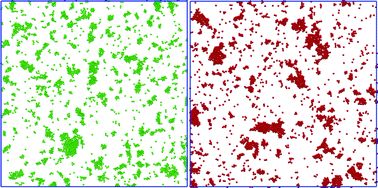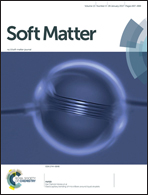Morphology of clusters of attractive dry and wet self-propelled spherical particle suspensions†
Abstract
In order to assess the effect of hydrodynamics in the assembly of active attractive spheres, we simulate a semi-dilute suspension of attractive self-propelled spherical particles in a quasi-two dimensional geometry comparing the case with and without hydrodynamics interactions. To start with, independent of the presence of hydrodynamics, we observe that depending on the ratio between attraction and propulsion, particles either coarsen or aggregate forming finite-size clusters. Focusing on the clustering regime, we characterize two different cluster parameters, i.e. their morphology and orientational order, and compare the case when active particles behave either as pushers or pullers (always in the regime where inter-particle attractions compete with self-propulsion). Studying cluster phases for squirmers with respect to those obtained for active Brownian disks (indicated as ABPs), we have shown that hydrodynamics alone can sustain a cluster phase of active swimmers (pullers), while ABPs form cluster phases due to the competition between attraction and self-propulsion. The structural properties of the cluster phases of squirmers and ABPs are similar, although squirmers show sensitivity to active stresses. Active Brownian disks resemble weakly pusher squirmer suspensions in terms of cluster size distribution, structure of the radius of gyration on the cluster size and degree of cluster polarity.


 Please wait while we load your content...
Please wait while we load your content...